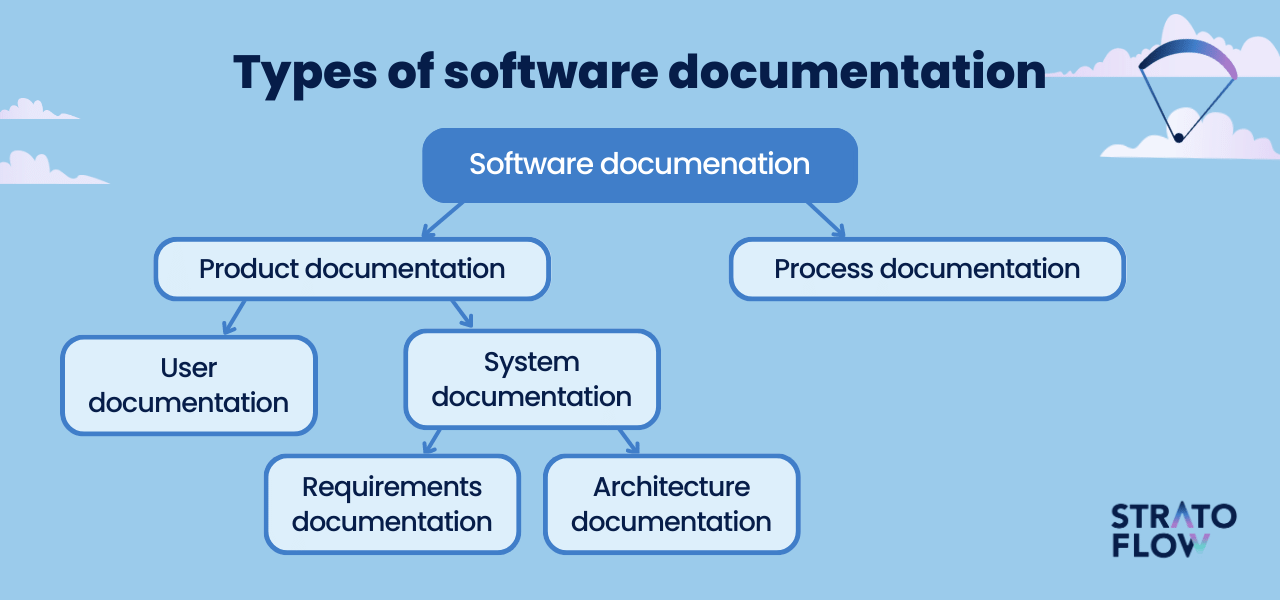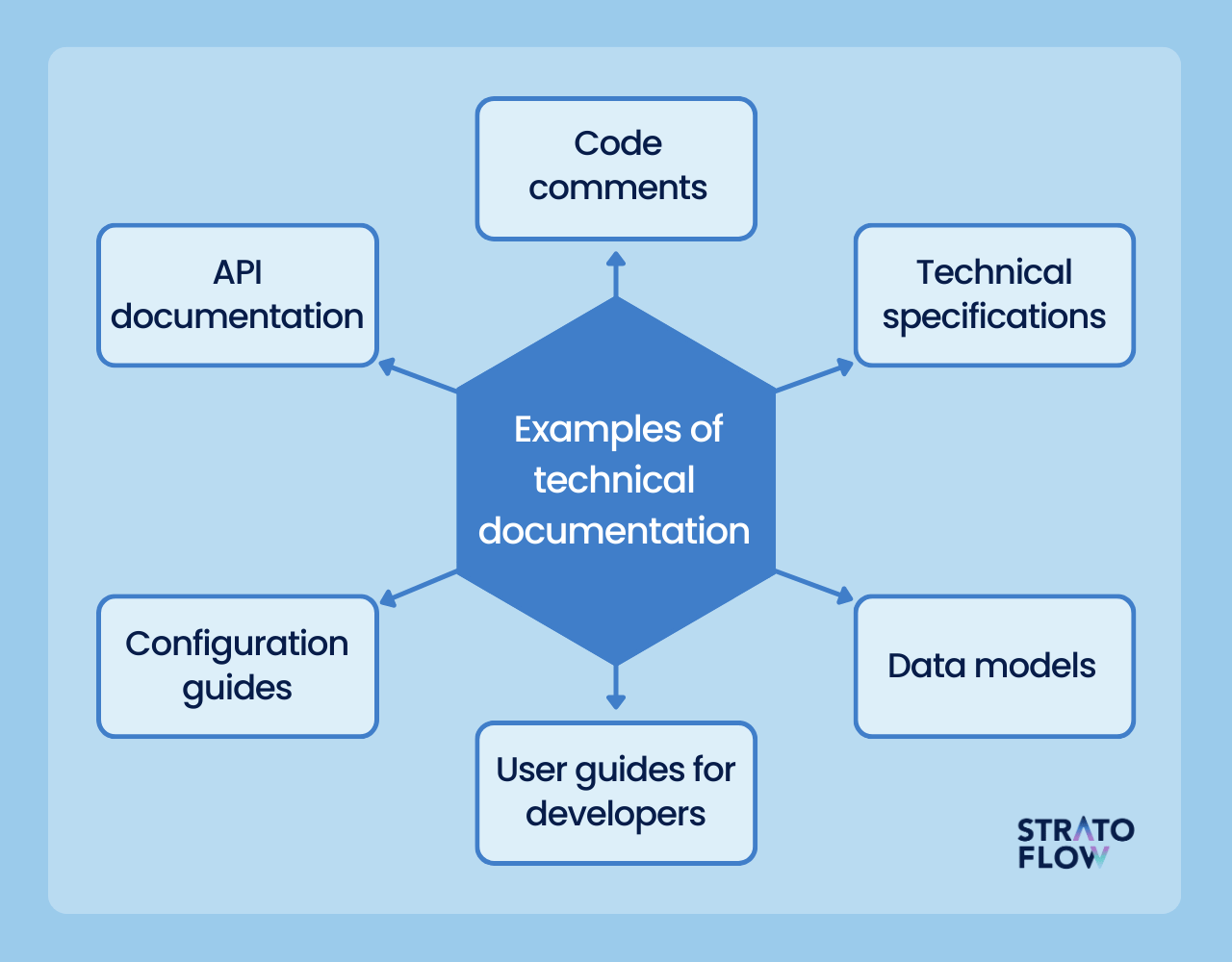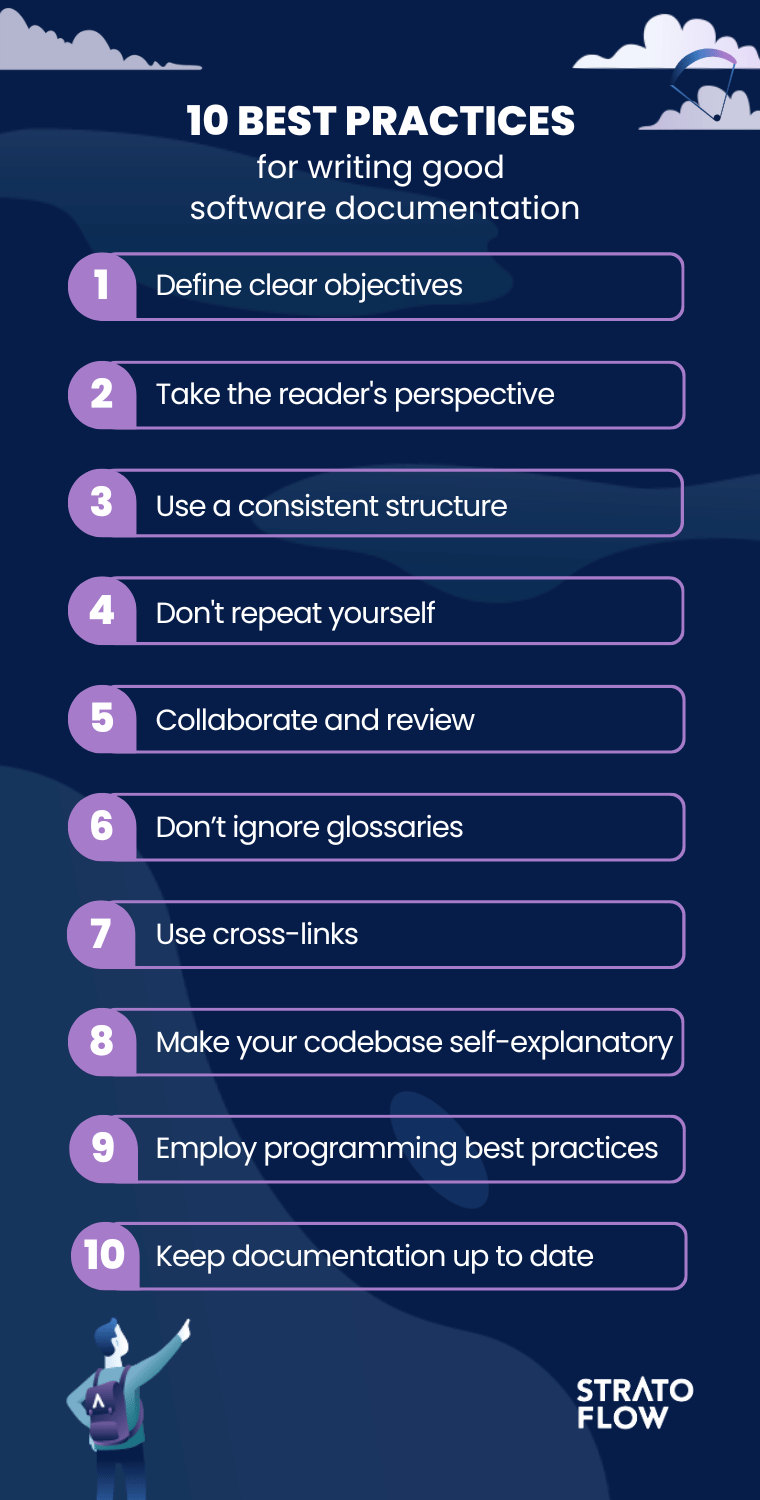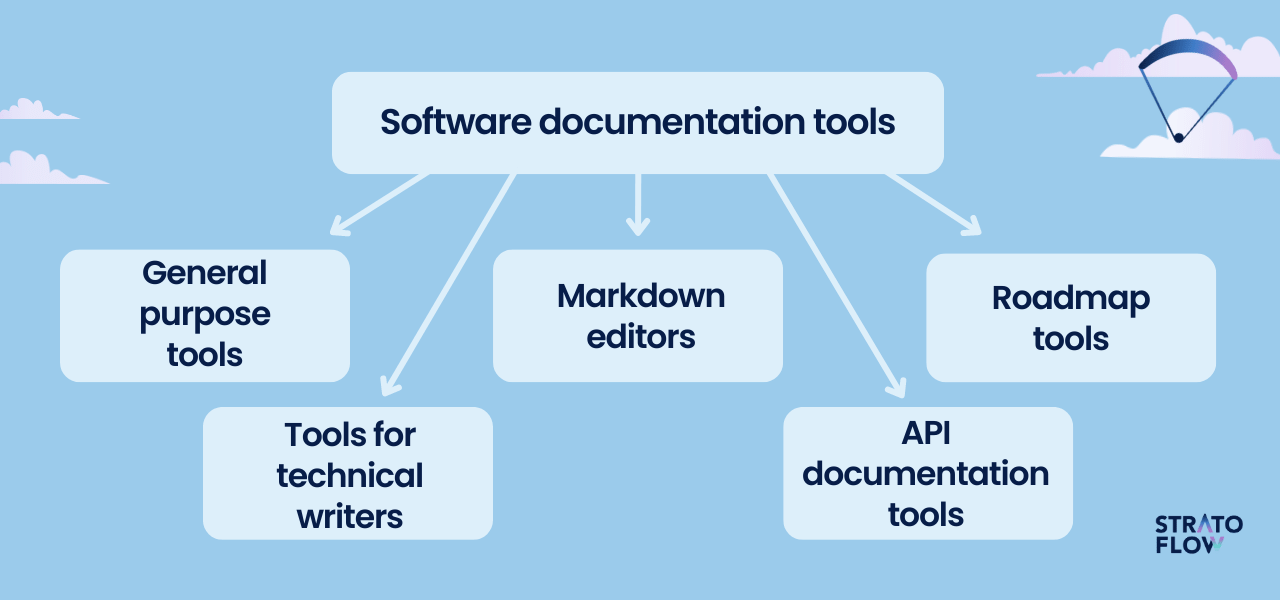
Software Documentation: Types, Best Practices, and Tools
In the complicated world of software development, success is often determined by the efficiency, functionality, and reliability of the final product.
But behind every groundbreaking software application is a hidden hero that is often underestimated, yet plays a crucial role in the project’s success – documentation.
In this article, we will explore the different types of software documentation and how each contributes to the software development lifecycle. We will also ask our most experienced developers to share some of their best practices for turning documentation from a boring chore into a valuable asset for all project stakeholders.
What is software documentation?
In short, software documentation is a comprehensive collection of written materials that describe and explain a software system or application. It includes various documents and artifacts that provide insight into the design, functionality, architecture, and use of the software. This documentation serves as a critical resource for developers, stakeholders, and end users to help them understand, use, and maintain the software effectively.
One of our senior programmers has put it that way:
Documentation, in my opinion, answers two fundamental questions: why? and how? From a programmer’s standpoint, it serves a purpose of a point of reference to the general concepts but also describes the details in the given domain and solutions that have been used.

The importance of software documentation
Software documentation serves as a cornerstone in the world of software development, benefiting a wide range of stakeholders involved in a software project.
At its core, developers themselves find immense value in documentation as a roadmap for understanding code, explaining complex algorithms, and facilitating team collaboration.
But programmers are not the only ones who benefit from thorough software documentation. Testers who can not only use documentation to design and implement automated regression software testing cases, but also to identify the most complex software features to double-check them with special attention. Beyond the development team, business managers find software documentation essential for making informed decisions, understanding project scope, and accurately estimating budgets and schedules. Customers and end users also benefit from easy-to-use documentation that eases onboarding and improves the user experience.
In essence, software documentation becomes a guiding beacon that unifies stakeholders, fosters transparent communication, and drives software projects to success.
Who uses software documentation?
From the birth of a project idea to the moment it’s released into the hands of users, software documentation plays several important roles.
First, documentation acts as a common language and knowledge base that facilitates communication and collaboration among individual team members, including developers, designers, testers, and project managers. It ensures that everyone involved in the project understands the system’s components, interfaces, and requirements, leading to better teamwork and smoother project execution.
It acts as a roadmap, guiding developers through the intricacies of the codebase and helping them understand the rationale behind design choices. Typically, a development team consists of dozens of talented individuals, each with their own unique approach to coding. Documentation is like a blueprint that each team member can refer to when someone else’s style of writing code is unclear.
At the same time, it empowers stakeholders to make informed decisions by providing a clear view of the project’s progress and aligning expectations with reality.
5 types of software documentation
As you might have guessed, there’s no single document that falls under the category of software documentation. Rather, it is an umbrella term for all documents that aim to explain and guide you through the complexities of software.
Let’s explore five major types of software documentation, each serving a unique purpose and addressing different aspects of the development lifecycle.

1. Process documentation
First, we have process documentation, which focuses on capturing and describing the workflows, procedures, and software development methodologies involved in a software development life cycle.
Its main purpose is to provide a clear and structured framework for the custom development process, ensuring consistency and efficiency among team members. This type of documentation serves as a comprehensive guide for project managers, system administrators, software developers, and stakeholders, enabling them to understand the sequence of tasks, dependencies, and responsibilities throughout the software lifecycle.
When can process documentation be useful?
Imagine a situation where the development team is preparing to release a major update or new version of their application. As the release date approaches, the development team needs to ensure that the software has been thoroughly tested for bugs, glitches, and compatibility issues to deliver a stable and reliable product to users. A well-documented QA process flowchart allows the team to follow a standardized testing procedure, ensuring that all essential tests are performed consistently.
Above all, process documentation plays an important role in facilitating seamless collaboration and knowledge sharing within the development team. It ensures that everyone is aligned with established procedures and practices, which ultimately contributes to smoother project execution and successful outcomes.
There are two popular examples of documents falling into the category of process documentation:
- Process Flowcharts – Visual representations of the step-by-step sequence of activities and decisions in a software application development process, providing a clear overview of the workflow and potential branching paths.
- Standard Operating Procedures (SOPs) – Detailed written instructions that outline the specific tasks, roles, and responsibilities for each phase of the software development lifecycle, ensuring consistency and adherence to established processes.
2. Requirements documentation
Process documentation answered the “how” question. Now let’s answer the “what” question by taking a closer look at requirements documentation.
Requirements documentation is a subset of broader system documentation that focuses on capturing and specifying both the functional and non-functional requirements of a software project.
It includes a detailed outline of the software’s intended features, functionality, and performance expectations. This documentation serves as the foundation for the entire development process, providing a clear roadmap for creating the software and guiding the work of developers, designers, and testers.
From a business perspective, requirements documentation is critical because it aligns software development efforts with the organization’s strategic goals and customer needs.
It acts as a contractual agreement between stakeholders and the development team, ensuring that everyone has a common understanding of the project’s scope and deliverables. Neglecting or overlooking requirements documentation can lead to miscommunication, scope creep, and costly project delays.

Here are five key subtypes of requirements documentation that are very common especially in larger software development projects:
- Software Requirements Specification (SRS) – It is a comprehensive document that provides a detailed description of the software’s functional and non-functional requirements. It includes user needs, system capabilities, constraints, and interfaces, serving as the foundation for the entire development process.
- Use Cases – Descriptions of interactions between users (actors) and the software, illustrating how the software responds to various user actions. Use cases help in identifying system behavior and understanding user interactions with the application.
- Functional Requirements – It includes statements that specify the software’s expected behavior and the actions it must perform in response to certain inputs. In other words, functional requirements define the features and functionalities that the software should deliver.
- Non-Functional Requirements – Contrary to its non-functional counterpart, this type of documentation specifies system qualities, such as performance, security, usability, scalability, and reliability.
- User Stories – These are short, user-centric descriptions of software features from an end-user’s perspective. User stories focus on capturing specific functionalities and benefits that users expect from the software.
3. User documentation
The previous two types focused on the technical stakeholders of the project but those who lack any programming knowledge are just as important in the vast majority of cases, and that’s the role of user documentation. It is a critical type of software documentation that focuses on providing information and instructions to end-users on how to effectively use and interact with a software product.
It serves as a bridge between the technical complexities of the software and the users’ perspectives, making the software accessible and usable. User documentation plays a pivotal role in enhancing the overall user experience, as it empowers users to make the most of the software’s functionalities and features. Well-crafted user documentation can significantly reduce the learning curve for new users, increase user satisfaction, and minimize the need for customer support.
We also have a second guide that is a description of software functionalities from both a business and technical perspective. We also release it to customers/users as a manual, but as it turns it, from time to time, becomes really handy for developers as well.

From comprehensive user manuals and step-by-step guides to interactive tutorials and tooltips, user documentation comes in various forms, catering to different levels of user expertise. Here are seven main examples of user documentation
- User Manuals – Comprehensive guides that provide detailed instructions on how to use a software product, including setup, navigation, and feature explanations.
- Online Help Systems (OHS) – Context-sensitive assistance embedded within the software interface, offering immediate guidance to users based on their actions or queries.
- Tutorials – Step-by-step instructional materials that walk users through specific tasks or workflows, helping them gain hands-on experience with the software.
- Knowledge Bases – Extensive repositories of articles, guides, and troubleshooting resources, empowering users to explore and resolve more complex software development problems independently.
- Release Notes – Documents highlighting new features, bug fixes, and changes in software updates, keeping users informed about the latest improvements.
- User Guides – Targeted documentation tailored to specific user roles or use cases, providing focused guidance based on user needs.
- Video Tutorials – These are visual guides in the form of videos, demonstrating software functionalities and guiding users through specific tasks.
4. Architecture design documentation
Now let’s move on to the types of software documentation that are primarily aimed at software developers themselves, and first on that list is architecture documentation. Architecture documentation is a critical type of software documentation that deals with the structural design and organization of a software system.
It provides a comprehensive view of the software’s high-level components, their interactions, and the underlying architecture that governs the application’s behavior. This documentation serves as a detailed blueprint that helps developers, architects, and other stakeholders understand the complexity of the system and make informed decisions during development, maintenance, and future enhancements. Architecture documentation also plays a critical role in ensuring the scalability, maintainability, and robustness of software, as it outlines the rationale behind design decisions and helps teams identify potential bottlenecks or areas for optimization.
Here are three key types of architectural documentation commonly used by development teams:
- High-Level Architecture Diagram – A visual representation of the software’s overall structure, showing major components, their interactions, and the flow of data. This diagram provides a high-level view of the system’s architecture and helps stakeholders understand its key building blocks.
- Data Flow Diagram (DFD) – Another graphical representation of how data flows through the software, depicting inputs, outputs, and data processing steps. DFDs assist in visualizing data transformations and identifying potential bottlenecks or areas for optimization.
- Class Diagram – A depiction of the software’s class structure, showing classes, their attributes, methods, and relationships. Class diagrams are valuable for understanding the software’s object-oriented design and inheritance relationships.
Read also: [What is a Tech Stack and How to Choose One?]
Technical documentation
Finally, we come to the technical documentation – a critical component of every software development project, serving as a comprehensive resource that provides in-depth insights into the inner workings of the software.
This type of documentation is specifically designed for developers, offering a detailed understanding of the codebase, algorithms, APIs, and other technical aspects. Technical documentation offers great help for developers, empowering them to navigate the complexities of the code and architecture efficiently.
Technical documentation should primarily describe in general what the thing (class, method, field) is used for. For me, it is important that it also explains how certain things behave in boundary conditions, i.e. whether they return a defined error or null, or throw an exception.

In large projects encompassing hundreds of classes, it is impossible to know every detail about the code. And that’s the key role of technical documentation – clarifying the purpose and usage of functions, classes, and modules, enabling developers to collaborate and maintain code consistency even in very robust software applications.
Sometimes applications are built as standard and are simple, then such additional explanation is just not needed. But in large, in enterprise software, ways of starting various development tools, firing up the product, and loading some data into it are not standard, so new programmers would not know how to do it and you would have to explain to each one individually.
Apart from that, technical documentation plays a pivotal role in supporting ongoing development efforts, bug fixing, and software updates. By providing clear and accurate references to the codebase, it helps developers troubleshoot issues and make informed decisions about optimizations and improvements especially when dealing with legacy software systems.
It is impossible for every programmer to know every single functionality. When he needs to do/change something in it, that’s when we reach for the Technical Guide to refresh our knowledge.

From this description, technical documentation seems quite similar to the previously mentioned type – architectural documentation. So what’s the difference between these two subtypes?
First and foremost, technical documentation focuses on the low-level implementation details of the software and is primarily aimed at developers for efficient coding, debugging, and maintenance. Architecture documentation, on the other hand, provides a high-level overview of the software’s design and interactions and is intended for a broader audience to facilitate decision-making and project planning. However, both types of documentation are essential for successful software development, and each plays a unique role in ensuring the effectiveness and maintainability of the software.

Some examples of technical documentation include:
- Code comments – Inline explanations within the source code that provide context, rationale, and explanations for specific code segments, making the code more understandable and maintainable.
- API documentation – Comprehensive documentation that describes the usage, parameters, return values, and functionality of application programming interfaces (APIs), enabling developers to integrate external services or libraries seamlessly.
- Technical specifications – Detailed descriptions of the software’s technical requirements, design decisions, data formats, and protocols, aiding developers in understanding the overall system architecture and implementation.
- User guides for developers – Instructional materials specifically tailored to help developers effectively use software libraries, frameworks, or SDKs, simplifying system integration and promoting best practices.
- Data models and database schema – Documentation detailing the structure, relationships, and constraints of the database tables and data models, assisting developers in database management.
- Configuration guides – Instructions on how to set up and configure the software environment, ensuring consistent deployment and optimal performance.
10 best practices for writing good software documentation
For most software developers, writing software documentation is one of the most boring tasks there is. After all, it involves almost none of the creative and analytical thinking that makes being a software engineer fun and challenging, and it involves writing rather boring code and feature descriptions.
However, as we have emphasized in the previous paragraphs, solid documentation is often just as important as high-quality code. That’s why we asked some of our most experienced software engineers to share their tips and best practices for writing good software documentation.
Read also: [Latest Software Development Trends 2023]

1. Define Clear Objectives
First things first – clear objectives.
There are a number of different documents that make up comprehensive software documentation, and each one serves different purposes and users. Defining clear objectives for software documentation means establishing specific purposes and goals for each document. These objectives outline the intended audience, the type of information to be included, and the scope of coverage.
By defining clear objectives, documentation becomes focused and relevant, better meeting the needs of developers, end users, and stakeholders. This approach ensures that the documentation remains focused and aligned with the overall project goals, promoting better understanding and successful project outcomes.
2. View software documentation from the reader’s perspective
When writing any type of software documentation, think about who will read it and how technical that person is.
Is it a user manual? You should use broad language and focus mostly on system functionality. Is it the technical garb of a developer? As the name suggests, you should delve into all the details of the software’s inner workings, since your primary audience will be familiar with all the technical terms.
Adopting a reader-centered approach helps create documentation that resonates with users, making it easier for them to find relevant information and navigate through the content effortlessly. Adopt an approach that anticipates and proactively addresses readers’ questions and concerns by presenting information in a clear, concise, and user-friendly manner.
3. Use a consistent structure
You wouldn’t want to read a book if the author’s writing style changed every chapter. The same is true for software documentation.
When writing documentation, regardless of the audience, you should always use a consistent style and formatting. A concise structure for software documentation provides readers with a familiar and predictable format and greatly improves the overall comprehensibility of the document.
Using standardized headings, subheadings, and formatting throughout all documents makes it easier to navigate and retrieve information. A consistent structure ensures that the documentation is organized logically, allowing users to locate content efficiently. A consistent structure makes the documentation easier to use, promotes collaboration among team members, and enhances the professionalism of the software project.
You can also go a step further and establish a more formal style guide for all developers involved in writing documentation for the project, as this provides a number of valuable benefits.
- A style guide can help establish a clear and coherent tone for the documentation you write.
- It can help ensure consistency in the software documentation process.
- It can help improve the overall quality of any software documentation you create.

4. Don’t repeat yourself
If you are at all connected to the custom software development market, you have probably heard of the KISS and DRY principles of software development. The latter translates to “don’t repeat yourself” and should be applied to software documentation as well.
If a particular method or line of code is fairly self-explanatory, there’s no need to include a special explanation in the comments or accompanying documentation. It is a waste of time for both the writer and the reader of software documentation, and in some cases it can lead to more confusion than clarity.
Don’t write by hand in the documentation what can be understood from the source code itself. It’s tedious for a programmer to repeat the same thing in two places, and moreover, it’s easy for it to become disjointed since there could be discrepancies between what was written in the documentation and in the code.
For this reason, avoiding repetition in software documentation can do wonders for the overall clarity and conciseness of the project.
In my opinion, it is better if the documentation is written briefly and concisely without unnecessary beating around the bush.

Repeating the same information in multiple places can lead to confusion and difficulty maintaining accuracy. Instead, focus on providing information in a single, authoritative location, and use cross-references or hyperlinks where appropriate. By adhering to the principle of not repeating yourself, documentation remains streamlined and easier for readers to understand, reducing the risk of inconsistencies and improving its overall effectiveness.
5. Collaborate and review
Sometimes you are not sure what to include in the documentation.
Some information may seem self-explanatory and obvious to you because you’ve worked on a particular feature, but your logic may not be as clear to other team members. For this reason, writing software documentation must be a collaborative effort.
What do we mean by that?
Just like the code itself, the documentation needs to be reviewed. Give it to your colleagues and see if they think it’s easy for them to understand. Get feedback from your customers, too. Wojtek, one of our senior software developers, suggested such an approach:
I recommend an approach, that if someone (user/administrator/programmer) asks about something on Slack or by email, it’s because he does not know what to do and how certain things work. We should be able to refer him to the technical documentation instead of writing back with an answer.

If you have a question about a particular feature or piece of code, it’s very likely that someone else will have the same question soon. If something was incomprehensible to one person, it is likely to be incomprehensible to others.
By embracing collaboration and review practices, software documentation becomes a collective effort that benefits from the expertise of multiple stakeholders. The result is documentation that is accurate, comprehensive, user-centered, and contributes to the overall success of the software project.
6. Don’t ignore glossaries
Another part of software documentation that all devs should remember about are glossaries. Including them in projects ensures greater clarity, consistency, and effective communication throughout the development process.
A glossary serves as a centralized repository of essential terms, acronyms, and technical jargon used in the software, accompanied by their clear and concise definitions. When technical jargon and specialized terminology are defined in a glossary, it becomes easier for readers to comprehend the documentation. A well-maintained glossary supports effective communication and ensures that all team members and users share a common understanding of critical terms within the software context.
From a user perspective, including a glossary in user documentation makes the software more accessible and user-friendly, as it empowers users to grasp technical concepts without having to seek external sources for clarification.
7. Use cross-links
The use of cross-links in software documentation is paramount because it improves navigation, facilitates information retrieval, and promotes a more seamless and cohesive user experience.
Cross-links act as navigational aids by connecting related sections, topics, or documents within the documentation. This connectivity allows users to move effortlessly between different parts of the documentation to access additional context or related information without having to search. For developers, cross-links streamline the process of understanding code dependencies and functionality by linking code references to detailed explanations or documentation sections.
8. Make your codebase self-explanatory
As we now know, the main purpose of technical documentation is to explain to other team members how certain parts of the code work and what they are responsible for.
Let’s take this concept a step further and aim to write software in such a way that other developers don’t have to wade through lengthy doc files to understand the concepts, but can simply read the code to understand how it works. This is the general concept behind clean code – code that is concise, well-written, and most importantly, easy to understand. As a result, other team members will not have to wade through documentation so often to get a full understanding of the code’s logic.
Of course, that’s not enough.
Large software development projects can contain thousands of classes. It is like looking through a multi-volume encyclopedia – even though everything is included in the codebase, we are not sure which class to start reading from.
A sort of bird’s eye view is needed, and that’s the role of developer and technical guides. These should be like entry points into the project for new programmers-describing various caveats and features in a concise way, so that the programmer understands the basic concepts enough to dive deeper into the hundreds of classes and thousands of lines of code in the main project itself.
9. Treat your documentation the same way as your code
Another rule of creating software documentation is that handwritten code documentation should be treated the same as code.
What do we mean by this?
Over the years, there have been countless lists of best practices for software development written by various authors. They include tips on how to format your code to make it look good, what naming conventions to use, and how to emphasize the importance of code reviews. A good rule of thumb is to apply the same best practices to software documentation. Let’s take code reviews, for example. Wojtek suggests that software documentation should be reviewed in the same way as code.
Once your documentation is written, you should read it for yourself once more and refactor it as necessary. Then hand it over to someone else to read and to check whether everything is understandable.

This sort of practice will help you get to the bottom of what is causing problems and what is still hard to understand. Then you can work on improving the documentation so that the next people will have it easier.
10. Keep your software documentation up to date
Last but not least, let’s talk about updates, because keeping software documentation up-to-date is critical to its accuracy and relevance.
When the software undergoes changes, such as updates or bug fixes, the corresponding documentation must be updated promptly to reflect these changes. Outdated documentation can lead to misunderstandings and hinder development efforts.
Implementing version control mechanisms and regularly reviewing and updating documentation ensures that it remains reliable and reflects the current state of the software. Keeping documentation current increases its value as a trusted resource for users and team members alike, supporting effective decision-making and successful project management.
Software documentation tools
To streamline the documentation process and improve its quality, various software documentation tools have emerged, each designed to meet specific needs and workflows. Today, there are so many options on the market that it is difficult to choose something suitable for a given project.
In our experience, any software documentation tool will do, as long as the documentation source code is kept in text files in git, and as long as links between sections are possible.
One thing is for sure writing documentation in Word is futile – we’ve been through this – no version/change control in a way that makes sense to the programmer, no way to impose consistent formatting, etc. It’s also important that the rendered documentation be available online, i.e. if someone adds something there in the documentation, someone else can read it right away in a nice form.
Let’s now very briefly cover some of the most popular tools that help software developers with writing and maintaining software documentation:

General purpose tools
Numerous collaborative tools are available to aid software development teams in expressing requirements, sharing information, and documenting features and processes. Here are three examples:
- Atlassian Confluence – It is a team collaboration platform that enables users to create, organize, and share rich content, making it ideal for collaborative software documentation and project knowledge management.
- Document360 – It is a knowledge base software specifically designed for creating and maintaining software documentation, providing features like versioning, role-based access, and integrations for efficient documentation management.
Markdown editors
Markdown editors are specialized tools for writing and formatting text using simple syntax, which can then be easily converted to various formats such as HTML or PDF. They are popular with developers and technical writers for creating documentation in a lightweight and readable format.
- Visual Studio Code – An integrated development environment (IDE) with built-in support for Markdown. It provides features like live preview and extensions for enhancing Markdown editing, making it a favorite among developers for writing technical documentation.
- Typora – A minimalistic, distraction-free Markdown editor with live preview capabilities, allowing users to focus solely on content creation and immediate visual feedback.
- Quiver – Quiver is a note-taking app designed for programmers, offering a flexible and organized platform to write, edit, and organize code snippets, markdown notes, and rich text, ideal for software developers who need a versatile tool for documenting and managing code-related information.

Roadmap tools
Another type of software documentation tools are roadmap tools. They help in visualizing and planning the development process, making them useful for documenting the project’s progress, milestones, and future directions. These tools often allow project managers to create timelines, track tasks, and communicate project status to stakeholders.
- Aha! – is a product roadmap software that provides a suite of tools to manage the entire product management lifecycle, from idea to launch.
- Jira – A powerful issue and project tracking tool often used in agile software development. It provides project boards, epics, and sprints, enabling teams to create and manage software development roadmaps and documentation.
- ProductPlan – is a cloud-based product roadmap software that provides features for roadmapping, timeline creation, collaboration, prioritization, and reporting to help businesses develop, share, and manage their product roadmaps in a more efficient and effective way.
Tools for technical writers
Tools designed specifically for technical writers offer advanced features and capabilities that streamline the documentation process. These tools often focus on managing large documentation projects and facilitating collaboration between writers and subject matter experts.
- MadCap Flare – A comprehensive authoring tool for technical documentation that supports multiple output formats, including HTML, PDF, and online help. It enables writers to create single-sourced content and manage complex documentation projects efficiently.
- Adobe FrameMaker – A powerful desktop publishing software tool tailored for technical documentation. It provides advanced formatting and layout options, making it suitable for creating professional, print-ready manuals and guides.
API documentation tools
API documentation tools are specialized platforms that automate the process of generating documentation for software APIs. These tools extract relevant information from code comments or annotations and create readable and interactive API documentation.
- Swagger (now known as OpenAPI) – An open-source framework for designing, building, and documenting APIs. It allows developers to create machine-readable API specifications, which can be converted into human-readable API documentation automatically.
- Postman – A popular API development and testing platform that includes features for generating API documentation. It allows developers to create and publish interactive API documentation for easy reference and sharing with stakeholders.
Conclusion
Even though many consider it to ba a boring chore, software documentation in reality is the art of capturing the essence of a project, transcending the lines of code, and transforming technical complexities into a language that bridges the gap between developers, stakeholders, and end-users.
Culture of meticulous documentation elevates custom software development projects to new heights, resulting in faster delivery, improved collaboration, and software solutions that surpass client expectations, standing the test of time in the dynamic and ever-changing technology landscape.
Related Posts
Thank you for taking the time to read our blog post!